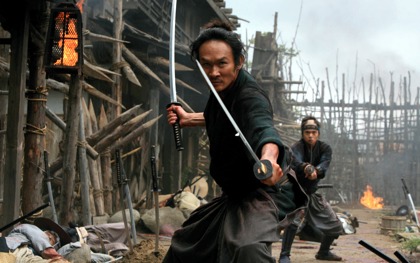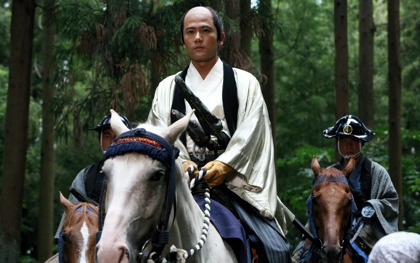Primary navigation


The prolific Japanese director Miike Takashi is never afraid to shock audiences. But the shock with 13 Assassins is that he has delivered a classical samurai movie worthy of Kurosawa. By Christoph Huber
Something funny happened at last year’s Venice Film Festival. After the world premiere of 13 Assassins (Jûsan-nin no shikaku) in competition, critics hitherto hostile to the work of the prolific Japanese director Miike Takashi suddenly started to rave about the Kurosawa-like classicism of his new sword-fighting spectacular. At the same time, many of the director’s long-time admirers complained that – for all its technical virtuosity – it lacked the personal touch. Had the enfant terrible of Japanese cinema sold out on reaching his 50th birthday?
In fact, if anything, Miike’s recent films seem every bit as extravagant as the breathless preceding career (more than 80 works in 20 years) that has established him as one of the most original Asian auteurs. Not only did Venice also host the near-simultaneous premiere of Miike’s typically idiosyncratic and enjoyably surreal superhero sequel Zebraman 2: Attack on Zebra City, but as a voluptuous death dirge 13 Assassins hardly seems the stuff of international blockbuster security, no matter how amazing Miike’s handling of action – and the final battle, an impressively mounted presentation of criss-crossing strategic movements escalating into mayhem, vies for instant classic status. Lasting 45 minutes, it gives viewers the sense of witnessing chaotic bloodshed in real time, but the mise en scène is so purposeful that we never lose our bearings. Miike’s magisterial craftsmanship is beyond doubt as he sets up another complex study of violence and its implications.
A remake of a 1963 film by the neglected master Kudô Eiichi, 13 Assassins is on the face of it a traditional story of a group of obsolete samurai going out with a bang, as swordsman Shinzaemon Shimada (Yakusho Kôji) assembles a team of assassins to take out the murderous, sadistic – and thus potentially politically dangerous – Lord Naritsugu (Inagaki Goro). Unlike, say, Miike’s subversive 2002 update of Fukasaku Kinji’s yakuza classic Jingi no hakaba (Graveyard of Honour, 1975), this is a remake that sticks closely to the original.
Kudô’s film was the first in his terrific 1960s trilogy of black-and-white jidaigeki (period dramas) that used the guise of a historical setting to address Japan’s contemporary political conflict, presenting poor and marginalised samurai battling corrupt authorities as equivalent to the rebellious 60s student movement. Removed from that political context, Miike’s film – for all its fidelity – comes across as a classical genre exercise. The new 13 Assassins even starts the same way as the earlier version – the ritual suicide of a retainer that sets the plot in motion is a crisp, confrontational set piece that also establishes Miike’s dark, cool yet velvety digital palette. But by the end his film feels, if anything, more old-school than Kudô’s flight of madness.

Much has been made of the absence of ‘Miikesque’ moments – those idiosyncratic, sometimes shocking bits cherished by many of his fans. Unlike Kudô, however, Miike actually shows a horribly mutilated woman after her fate at the hands of the villainous Lord Naritsugu has been recounted. (For an even more impressive follow-up, the mute victim mouth-paints her cry for revenge on a piece of paper: the subtitles render the characters as “TOTAL MASSACRE”.) There’s also a characteristic ominous / funny scene when the evil lord’s guards (wrongly) conclude it’s safe to enter a booby-trapped town at the sight of a little boy urinating in the square – not to mention the herd of burning cattle used in the most bizarre sleight of hand during the battle. Reportedly, more outré touches make up most of the extra 20 minutes of the extended cut shown in Japan – although there aren’t any gaps noticeable in the international-release version (the one that premiered in Venice).
Despite these typical touches, 13 Assassins does seem considerably more audience-friendly than is customary for this director. For one thing, it’s undeniably action-driven; the team come across less as individuals than as one strategic unit, in keeping with Miike’s own decision to make strategy the focus of his mise en scène. The first half of the film is devoted to establishing the situation and laying out the battle plan: to stand a chance against overwhelming odds, the assassins decide to stage an ambush in a village, where carefully prepared surprise traps and spatial advantages (rooftops, narrow passages) will compensate for their numerical inferiority. The second half presents the bloody results, punctuated by cheerful battle cries such as: “Only 130 more men to go!”
Unlike the heroes of Kurosawa’s Seven Samurai (1954), who are differentiated and humanised by their backstories, Miike’s samurai are afforded little room for individuality within their quickly sketched outlines. Only the hunter from the mountains who joins the team along the way (bringing their number to 13) stands out vividly as designated comic relief – a child of nature who repeatedly mocks the solemn devotion of the warriors and their code: “Your samurai brawls are crazy fun!” Former model Iseya Yûsuke acquits himself well in the part, while pop star Inagaki Goro oozes nefarious charisma as the handsome yet hideous villain Naritsugu.
Those are the meatiest roles, but Yakusho Kôji makes a stalwart protagonist as Shinzaemon, supplying this traditional heroic figure with touches of dark wit and fury. And it’s his character’s confrontation with old rival Hanbei (Ichimura Masachika) – once his sparring partner at the dojo, now the lieutenant of the evil lord – that provides the film with its emotional centrepiece. Even as Hanbei disapproves of his master’s ways, his sense of duty as a samurai makes him stay loyal to the bitter end, only to be posthumously humiliated by Lord Naritsugu’s characteristically impious treatment of his severed head. It’s a sarcastic punchline to one of the thematic questions that fuels the film: sure, the villain is marked by his utter disrespect for human life, but is there really such a big difference in principle between his (admittedly perverted) yearning for an age of war he never experienced and the samurai’s determination to die nobly according to that age’s adages – for what exactly?

Shinzaemon and Hanbei are brothers in spirit who find themselves on opposing sides, their meetings and inevitable face-off conveying a classical pathos which serves to remind us that, while Miike has long been misunderstood as a purveyor of ‘Asia Extreme’ provocations, he is actually one of the great humanists of contemporary cinema. Ever since the inception of the Miike cult in the West in 1999, the year that saw the release of his subversive melodrama of cruelty Audition (Odishon) and his yakuza film Dead or Alive (Hanzaisha), he’s been marketed mainly in terms of coolness, focusing on virtuoso violent spectacle, exotic weirdo humour and stylistic inventiveness.
This accounts for the frequent neglect of the spiritual aspects of his work (for example, the intimations of Buddhist hell in Dead or Alive), or of films in different keys (such as 2002’s Shangri-La, a sweet outsider tale of casualties of capitalism that’s a straightforward example of upbeat humanism; or 2005’s wonderful remake The Great Yokai War, a child-friendly fantasy and one of the great widescreen films of the last decade).
Within the classical construction of 13 Assassins, the ambivalence and complexity of Miike’s treatment of violence can be seen more clearly; despite the formal originality and versatility we expect from him, this film is more familiar and traditional in terms of its emotional impact. Of course, you could argue that Miike more than anyone has earned the right to do chambara (the swashbuckler genre) straight – he is, after all, also the man who made Izo (2004), the film that turned the samurai genre inside out for good. But like other Miike masterpieces, including its criminally under-seen counterpart God’s Puzzle (2008), Izo managed to conjure a unique mood all its own – a true essence of the ‘Miikesque’.
Miike Takashi explains the appeal of remaking 13 Assassins on page 53 of the June 2011 issue of Sight & Sound
Venice: storm in a bottle: Nick James’ first look at 13 Assassins at the Venice Film Festival (September 2010)
The wild bunch: Sight & Sound’s survey of 50 ‘mad, bad and dangerous’ directors (September 2009)
Shimura Takashi: the last samurai: Alex Cox on Kurosawa’s other favourite actor (June 2006)
Gohatto reviewed by Philip Strick (August 2001)
Ghost Dog the Way of the Samurai reviewed by Xan Brooks (May 2000)